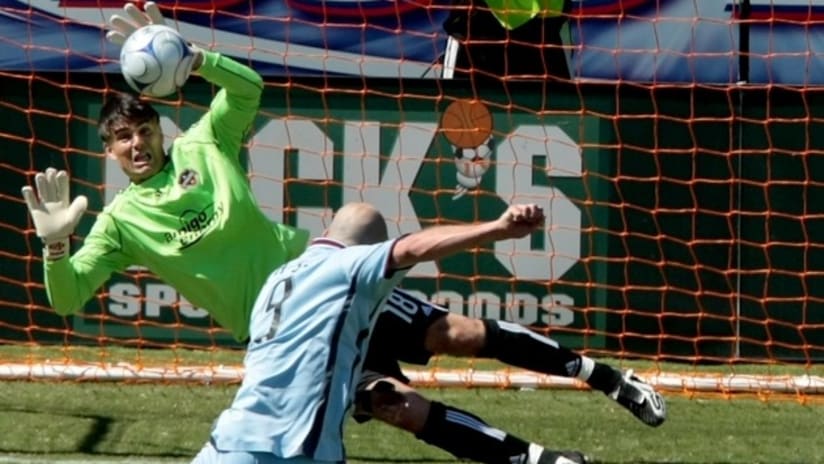This article appeared in the April 10, 2010 issue of the Houston Dynamo Gameday Magazine.
“You’ll never beat Pat Onstad!
You’ll never beat Pat Onstad!”
We chant that in the office from time to
time. It’s not technically accurate, but it feels like the right thing to say.
The confidence Onstad inspires – in teammates, coaches, fans, and even opponents
(confidence that he will deny them, of course) – has played a large part in his
success over the years.
Want proof? Go back to the videotape from 2006
and watch Jay Heaps walk to the penalty spot. You think he wanted to be there?
Facing a 6-foot-4 guy with a history of saving championship-game penalty kicks?
With the game on the line? Not so much.
Onstad’s career is most often
cited, unfortunately, for its timing. At 42 years old, he is the oldest player
in Major League Soccer and has been for quite some time. He made his first
senior appearance for his native Canada during the Ronald Reagan administration
in the country he now calls home. His three MLS Cup championships have all come
after his 35th birthday. He is older than the parents of teammate Danny
Cruz.
His career should receive even more acclaim for his consistent success,
which has resulted in a resume that compares favorably to any other goalkeeper
plying his trade on this side of the Atlantic. But Onstad inspires confidence
and admiration in those who know him best more for the subtleties of his game
and his personality than for the game-changing plays or game-day
bravado.
You don’t see what’s really going on with Pat Onstad. He jogs
onto the field for warm-ups, and immediately your eyes are drawn from the
understudy to the real deal. Onstad exudes confidence and comfort in his role
preparing to be the last line of defense for the league’s stingiest team, but
there’s something else beneath the calm façade.
“Yeah, I do still get
nervous,” Onstad admits. “Before the Dallas game [on March 27] … I was actually
almost too calm, and that made me nervous because usually I have some
butterflies. I always get nervous, regardless of whether it’s Game 15, Game 1,
Game 30, or the playoffs. I still enjoy it, though. I still have that drive and
hunger to try to win games, and as long as I have that, I’ll try to keep
playing.”
At controlling and conquering those nerves, Onstad is one of
the best MLS has ever seen. He has risen to big occasion after big occasion, but
his championship-game victories and MLS Save of the Year last year come
immediately to mind.
These plays stand out in the minds of fans and
teammates, something 21-year-old Tyler Deric knows well. Deric was a high school
junior when Onstad and the Dynamo moved from San Jose to Houston, and he has
seen Onstad perform from the stands as a fan, from the sideline as a teammate,
and from the pitch in practice. Deric knows that Onstad’s success goes far
beyond those high-profile moments.
“He has the ability to make the big
plays when we really need it,” Deric said. “When I watched him as a fan, I saw a
lot of leadership and that a lot of the players really respect what he does. …
Now that I’ve joined the team, his professionalism is great. He comes early,
stays late, takes care of himself, and is a great mentor for me to watch and
aspire to be as I get older.”
Onstad seems to have gotten better with
age and has displayed remarkable consistency, with his worst regular season
goals against average coming in at 1.28, and five seasons at 1.04 or lower. He
and his backline have led the league with the fewest goals allowed in MLS for
three consecutive years, although they did tie with Seattle for that honor in
2009.
Dynamo goalkeepers coach Tim Hanley, who coached Onstad in San Jose
and on two separate stints here in Houston, said Onstad’s mastery of the game’s
nuances often go overlooked.
“He’s always had a decent four guys in front
of him, so he manages it real well, gets guys organized, and in a way, I think
sometimes that’s taken for granted,” Hanley said. “You can limit opportunities
just because of good communication and having a good understanding and awareness
of the game, and Pat is great at that.”
Everybody can see when Onstad
tests his vocal cords with a well-timed shout at a defender or teammate, but
most of his contributions go unnoticed from the stands or press
box.
“There are going to be situations when he’s giving instructions and
all he might say is, ‘Right shoulder,’ so it’d be hard to pick up,” Hanley said.
“On set pieces, it might be a little easier to see him moving some bodies around
and figuring some things out. He’s great at the tiny, tiny things – the time,
how he uses the clock, and even dealing with the referees. … Those are things a
fan might notice.”
The subtleties of Onstad are there off the field, as
well. A Canadian international and proud representative of his native Vancouver,
Onstad has nevertheless taken to the United States so much that he now holds
dual citizenship.
“I’m a pretty political guy – always was in my country
– and have been even down here to a certain extent,” Onstad said. “I wanted to
be able to vote. I felt that was an important part of participating and living
in the United States, and that was one big reason. Another is that my wife’s
American, and I wanted to become American as well. I’m fortunate that I can
carry both passports, and at this stage this really is my adopted country –
except in ice hockey!”
Onstad says all the moving around – the joke goes
that the list of places he has not played is shorter than the list of places he
has – has been a positive, not a negative, despite the myriad of late-night
phone calls home from road trips. Even when he decides to end his playing
career, the moving around might not stop for Onstad, wife Becky, and children
Peyton, Owen, and Abigail.
“We’ve enjoyed our experiences in all the
different cities we’ve been to,” Onstad said. “We love the Bay Area, we love
Houston, but neither one of us knows where we’re going to settle. If I get into
the coaching world, which I’d like to do, you’re really chasing a job at that
point, just like a player.”
His coaching aspirations are not limited to
the goalkeeping position. Onstad has said before he would prefer to be a manager
or assistant coach rather than a specialist, and his ability to honestly
breakdown and assess games – before or after – show his understanding for much
more than just the goalkeeper’s role.
Perhaps it is that knowledge and
awareness – of self, team, and opponent – that inspire all around him to have
confidence in Pat Onstad.





